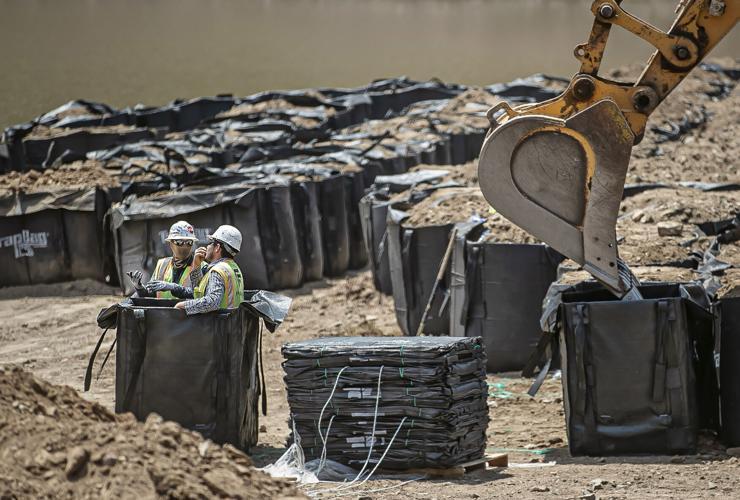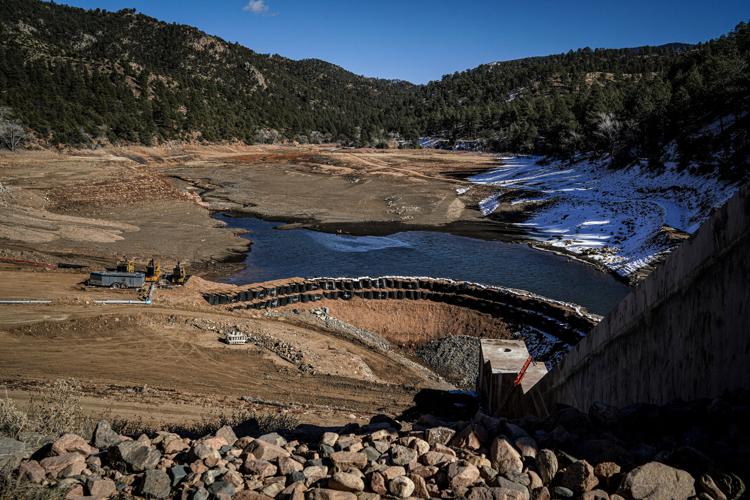Project Specifications
- Product Used: 4ft TrapBag Cofferdam Bags
- System Height: 8 ft
- Installation Configuration: Enclosed a 50 ft x 75 ft pump pad on the upstream face and tied into natural rock abutments on both sides.
- Material: Polypropylene geotextile with integrated lifting straps
- Fill Material: Locally quarried aggregate
- Reinforcement: Protective liner placed beneath cofferdam footprint
Initial Solution
To lower the reservoir’s forebay and safely expose critical intake infrastructure, TrapBag’s cofferdam system was used to create a secure enclosure for heavy equipment and crews. The cofferdam enclosed a 50 ft by 75 ft pump pad on the upstream face of the reservoir and tied into natural rock abutments on both sides to create a watertight seal.
- Engineered for Sensitive Environments: A liner was installed beneath the system to protect the clay substrate and increase friction.
- Rapid Installation: Modular 4ft TrapBag bags were pre-filled with local aggregate and placed using an excavator and an eight-point spreader bar. This unique basket-carried lift method preserved bag integrity while maintaining a consistent rectangular profile; which is critical for both installation speed and performance. Crews placed and leveled 12 bags per shift, completing the enclosure in just four days, ahead of schedule, despite high winds.
- Minimal Impact: The system’s profile and installation method minimized turbidity. This allowed the team to avoid puncturing the reservoir lining without requiring any permanent materials.
- Efficient Water Management: A 20 ft sump was excavated immediately behind the cofferdam, equipped with two 6-inch electric submersible pumps to manage seepage and maintain dry conditions.
Performance
The TrapBag system performed consistently under pressure from Santa Fe’s unpredictable mountain weather and fluctuating water levels. Its stable, rectangular profile held up to variable hydraulic forces from both sides during the fill and drain phases, making it a reliable containment structure for ongoing dam safety improvements.
- Accelerated Construction Timeline: The reservoir drawdown was completed ahead of schedule, allowing earlier access to the intake tower and penstock flange.
- Weather-Resilient Setup: Installation stayed on track despite sustained wind gusts over 20 mph.
- Environmental Stewardship: All materials—aggregate, liner, and cofferdam units—are reusable or recyclable, aligning with Santa Fe’s sustainability goals.
Key Outcomes
- Accelerated Project Timeline: Forebay drawdown and structure access achieved ahead of schedule
- Significant Cost Savings: Reduced temporary works costs by 35% compared to sheet piling
- Low-Impact, Sustainable Execution: No permanent materials left behind; all components reused or repurposed
Conclusion
The use of TrapBag’s cofferdam system at Nichols Reservoir demonstrates how municipalities can tackle critical infrastructure repairs in remote, environmentally sensitive areas, where sheet pile or earthen berms would be impractical.
TrapBag’s cofferdam system provided the City of Santa Fe with an adaptable, cost-effective solution for isolating key infrastructure within a sensitive reservoir environment. Originally chosen for its ease of use and environmental compatibility, the system exceeded expectations, helping crews stay ahead of schedule while protecting the city’s drinking water supply.
For photos and additional coverage of this project, explore:
- Santa Fe New Mexican – NM Water Authorities Underwater
- Santa Fe New Mexican – Construction Work at Nichols Reservoir Continues
Installation Highlights
- 4ft TrapBag Cofferdam Bags, 8 ft high
- Enclosed a 50 ft x 75 ft pump pad, tied into natural rock abutments
- Polypropylene geotextile bags with integrated lifting straps
- Filled with locally quarried aggregate
- Protective liner placed beneath the cofferdam footprint






